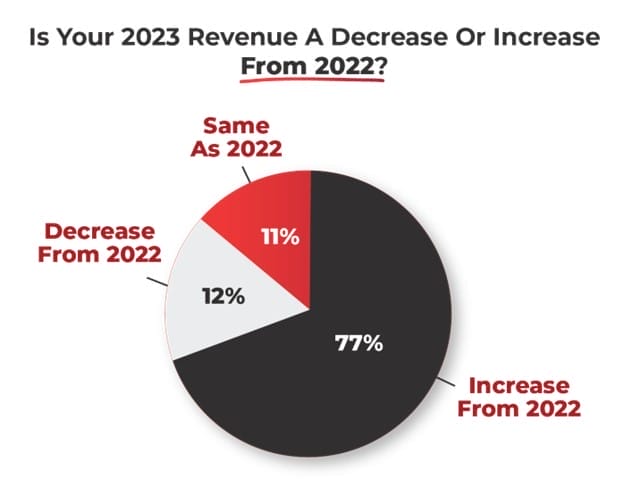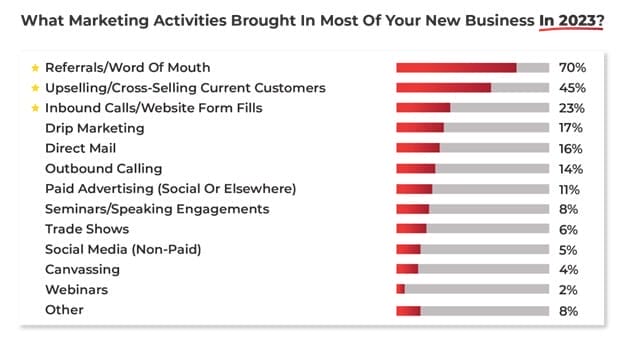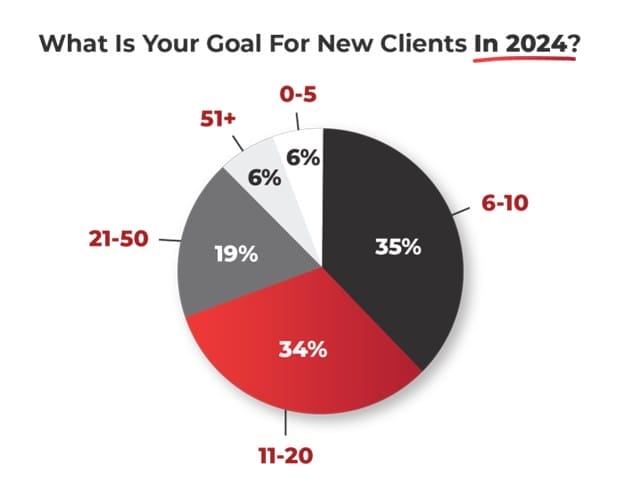Last year was a good year for MSP growth. The new MSP Success Annual Reporting & Predictions Survey finds that a whopping 77% of MSPs increased their revenue in 2023.
This is in line with recent data from other studies too. The Datto Global State of the MSP Report: Trends and Forecast for 2024 found that 68% of MSPs in North America experienced a revenue increase last year, with 38% growing by more than 10%. Similarly, Canalys found that the average MSP grew 12.9% in 2023.
“This is a great industry. You need to appreciate the fact that the rest of the economy doesn’t have what you have,” says Greg Crabtree, financial expert and author of Simple Numbers, speaking to MSPs at MSP Success’ recent 2024 MSP Growth Forecast online event.

But before you go patting yourself on the back, he warns, there are factors at play that make it likely that “you’re not going to be handed growth on a platter” going forward.
Indeed, though revenue projections for MSPs in 2024 are optimistic, new customer acquisition looms as a top challenge.
“We refer to the last 20 years as the ‘participation trophy economy,’” Crabtree explains. “This is now the ‘street fight economy.’ You’ve got to go take your fist, punch your competitor in the mouth, and take their customer away from them. That’s going to take true sales technique, true marketing techniques. You’ve got to up your game.”
(Want to see an easy way to “up your game,” ensure you’re not missing out on revenue AND keep your current clients happy? Check this out.)
MSPs Still Relying On Referrals For New Business, But …
That said, today referrals and word of mouth still dominate as the most effective marketing tactics for MSPs. Indeed, 70% of MSP Success survey respondents point to referrals as the marketing activity that drove the most new business in 2023.

For Steve Czeck, CEO of Empyrion Technologies, an MSP in the Vancouver, B.C., area, referrals and word of mouth are still the best source of new business, but he adds that personal networking and events have also “worked really well for us.” He’s gotten more involved in organizations like the local chamber of commerce as well as hosted some events and webinars. “I was trying to be more purposeful in our reach into the communities we serve,” he says.
David Stinner, president and founder of USitek, an MSP in the Buffalo-Niagara, New York area, finds the best marketing activity to drive growth has been networking—“building long-term relationships with people before they become prospects.”
He adds that asking for client referrals “results in new business every year.”
Asking for referrals is key. But most important, according to sales and marketing guru Robin Robins, is to have a strategic plan that fuels an endless chain of referrals. This plan includes building the “ask” into your sales process, publicly recognizing key clients through newsletters and your website, holding events and referral contests, sending thank you gifts, and more.
But leaning on referrals as your SOLE marketing strategy is not sustainable in this increasingly competitive customer acquisition landscape, however. The MSP Horizons Report 2024 from N-able, with research conducted by Canalys, states: “Typically, once an MSP gets beyond $2m in annual revenue they will need to cross the chasm and hire more dedicated salespeople and invest in marketing to continue to grow.”
Echoing Crabtree, The MSP Horizons Report finds: “Given the data also shows new customer acquisition is the most significant challenge for MSPs today, it is vital MSPs build more formal marketing and branding strategies.”
Chris Piedmonte, owner of ServantecGlobal, an Austin, Texas-based MSP he co-founded in 2018, agrees that referrals are effective but adds that they “did work hard to get into a number of third-party directory services, things like Clutch and Alignable and Upcity. We did pick up a couple of clients through those various services.”
Dan Sexauer, CEO and founder of Intevant, an MSP in Portland, Oregon, added two new clients last year—one came from a referral and one from a direct mail postcard campaign. “That’s the first time we’ve ever gotten a client from actual outbound marketing efforts,” he says.
Upselling Drives Growth Too
Another effective marketing tactic, according to 45% of MSP Success survey respondents, is upselling/cross-selling to existing customers.
Stinner, for instance, says he is more focused on selling additional recurring revenue services to existing customers than adding new logos. “We’re putting a big push on business intelligence as both project work and recurring revenue that we can sell to our existing customer base,” he says.
USitek, which was incorporated in 1999 and has 17 employees, is partnering with a BI specialist and has already achieved a few wins, he says.
Like Stinner, Sexauer anticipates new business from current customers. “We also have some cross-selling we can do to our clients still in regards to cybersecurity services. We’ve done a pretty good job, but I’ve still got some stragglers out there.” Adding to that opportunity will be the new managed detection and response (MDR) service he plans to roll out this year.
Sexauer is on track with market predictions. According to the N-able report, cybersecurity is the biggest opportunity for managed services globally, with 81% of respondents expecting growth in their cybersecurity solutions in the next three years.
Revenue Optimism For 2024
MSP Success survey respondents represent a width swath of business sizes, with their 2023 revenue ranging from under $1 million to $10 million. The business owners we spoke with are mostly optimistic about growing revenue in 2024. The N-able report finds that 64% of MSPs expect growth of over 10%.
Sexauer, for one, is “shooting for 15 to 20% growth.”
Stinner says USitek has been averaging 20% year-over-year growth for the past three years and expects to hit that again in 2024.
Piedmonte is optimistic for another year of 30-40% growth. “We consider ourselves an essential business component,” he notes. “So, no matter what’s going on, if you’re going to be in business, you need technology support.”
In contrast, Czeck is somewhat pessimistic about major growth for 2024 although he’s optimistic about profitability. He cites the economic conditions in the Vancouver area (high prices for goods, fuel, and real estate), plus the additional exchange rate he is taxed for his firm’s U.S. based tech products, as challenges.
The Customer Acquisition ‘Street Fight’
We asked survey respondents an open-ended question: What keeps you up at night in regards to your MSP?
Their responses include hiring and retention, competition, loss of a large client, new client acquisition, managing expenses, inflation, and more.

These concerns align with findings from a recent Slack survey of 2,000 small business owners—half comprised of businesses in tech or retail—where the top concerns for 2024 are inflation/economic conditions (47%), needing to raise prices (32%), and rising competition (24%).

The MSP Success survey results show that just over half (55%) of respondents added five or fewer new clients last year. Around 20% of MSPs added six to 10 customers last year, with another 20% adding 11-20.
Survey respondents do have optimistic goals about adding new clients in 2024, with 35% reporting a target of six to 10 new customers, and 34% shooting for 11-20. Just 6% are projecting five or fewer.
Empyrion, which has 28 employees and almost 300 customers, added 10 new customers last year. Czeck’s goal for 2024 is 12 new clients. “If we can get one a month, we’re pretty happy,” he says.
Intevant, which has six employees and just passed the $1 million revenue mark, has a goal to add two clients next year, according to Sexauer. Intevant is in the process of migrating to a new RMM, so he doesn’t expect that effort to pick up until the second quarter.
Still, Piedmonte acknowledges that new customer acquisition is what keeps him up at night. That’s because he lost two large clients at the end of last year that were acquired by larger companies with their own internal IT departments. So, he is focused on replacing that MRR in 2024.
Like Piedmonte, Intevant lost a large client to bankruptcy last year. Despite that, Sexauer says the company fully recovered “through [adding] two new clients and raising prices and cross selling.”
Stinner is also losing a long-term client this year because it is closing its doors, but he says replacing that MRR is not keeping him up at night. Nor does any other business worry. “I’ve been in business so long; I don’t let things bother me or keep me up at night.” He adds that he views any adversity as an opportunity to learn something new.
Labor Concerns, Competition
There’s no denying hiring and retention remain a challenges. Competition for workers and high salary demands are issues of concern for Czeck.
“Vancouver is a bit of a tech hub and so all the big companies get all the best talent and the rest of us are left with what’s left over.” He adds, “Where we are [in the Fraser Valley, east of Vancouver] we can’t compete with corporate salaries, so that’s a challenge.”
Competition for business is also a concern. “There’s a lot of companies out there trying to do what we’re doing,” says Piedmonte. “Everything from one-man operations all the way up to these large national organizations that have a national brand.”
Indeed, there has been a proliferation of mergers and acquisitions among MSPs, resulting in “super MSPs.”
Sexauer says he feels like there’s enough work to go around, however, so he isn’t that concerned about competition. “I think Portland is a little saturated and could use some consolidation, but the pie is so big, there’s enough for everybody.”
Stinner says he’s not worried about outside conditions like the economy, citing data that points to lowering inflation, continued low unemployment, and the fact that companies are still spending money on tech.
“I don’t see any threat in the economy coming, and I think our industry in general, where we’ve now become, post-pandemic, the necessary and important part of society,” Stinner says. “You don’t do anything without your cloud, your data, your IT provider because you can’t get by without it.”
Sexauer sums up, “I think the pandemic proved we can survive through anything.”
To truly thrive in the coming year, though, Crabtree recommends you get ready to throw a punch.












